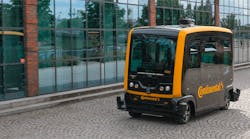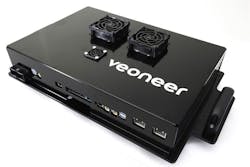Automakers to Base Autonomous-Driving Platforms on NVIDIA DRIVE AGX
At NVIDIA’s GPU Technology Conference (GTC) Europe, three leading automotive companies—Veoneer, Volvo Cars, and Continental—discussed plans for their next-generation of self-driving cars. All are basing their autonomous and semi-autonomous platforms on NVIDIA GPU-based computers.
Veoneer, an autonomous driving supplier spun out from tier 1 supplier Autoliv, has developed the "Zeus" computer, designed to meet the requirements for level 4 autonomous driving. It employs Zenuity's autonomous-driving software stack (Zenuity is itself a joint venture between Veoneer and Volvo Cars) and is based on the NVIDIA DRIVE AGX Xavier processors running NVIDIA DRIVE OS.
The computer is built on the NVIDIA Xavier system-on-a-chip (SoC), which integrates six different processors that accelerate diverse and redundant algorithms, including deep-learning artificial-intelligence software. Xavier delivers 30 trillion operations per second (TOPS) of performance while consuming just 30 W of power.
Zeus ECU
The Zeus board (Fig. 1) is an electronic control unit (ECU) that fuses data from cameras, radars, and other sensors (it provides the computational horsepower to process data from up to 27 sensors). Zeus then will interpret the situation and take required action. It’s been designed to meet the requirements of level 4 automation, as defined by SAE (Society of Automotive Engineers), meaning the system manages all dynamic driving tasks and, under most circumstances, requires no human interaction.
1. The Veoneer “Zeus” computer can accept data from up to 27 sensors.
Zeus will be production-ready in 2021, according to Veoneer. “We developed Zeus to provide safe mobility solutions, and it is an important step towards industrializing autonomous driving in 2021. Working closely with expert partners NVIDIA and Zenuity is key to innovate trusted solutions for future mobility,” said Jan Carlson, chairman, president, and CEO of Veoneer.
Volvo
Nvidia and Volvo are working together on a foundational technology built on DRIVE AGX Xavier that will initially feature Level 2+ assisted driving and scale up to Level 4 highly automated driving capabilities. The resulting system will integrate 360-deg. surround perception and a driver monitoring system. The platform will enable Volvo to implement new connectivity services, energy-management technology, in-car personalization options, and autonomous drive technology.
“A successful launch of autonomous drive will require an enormous amount of computing power as well as constant advances in artificial intelligence,” said Håkan Samuelsson, president and chief executive of Volvo Cars. “Our agreement with NVIDIA is an important piece of that puzzle and helps us to safely introduce fully autonomous Volvo cars to our customers.”
Continental
Continental’s Assisted & Automated Driving Control Unit (ADCU) will also be powered by NVIDIA DRIVE AGX Xavier. ADCU facilitates a safe and secure multipurpose processing platform said to be well-suited for applications in the realm of highly automated driving (HAD). This is achieved by integrating selected hardware and software that’s monitoring a vehicle’s motion and guiding its routing states at runtime.
Moreover, the ADCU executes an Environment Model (EM) based on signal feeds retrieved from onboard surveillance sensors and additional info. This is passed along to its trajectory planning algorithms to determine the optimal (ecological, safe, convenient) path and to coordinate the multitude of actuators (e.g., brake, suspension, etc.).
2. Continental’s CUbE is an example of a self-driving shuttle.
Continental’s Level 5 CUbE (Continental Urban moBility Experience) vehicle is designed for mobility-as-a-service (MaaS) automated shuttle operation (Fig. 2). It will run on the NVIDIA DRIVE AGX Pegasus computer. Pegasus achieves 320 TOPS of deep learning with an architecture built on two Xavier processors and two next-generation TensorCore GPUs. This AI computer, which runs an array of deep neural networks simultaneously, is designed to safely handle highly automated and fully autonomous driving without the need for a steering wheel or pedals.



